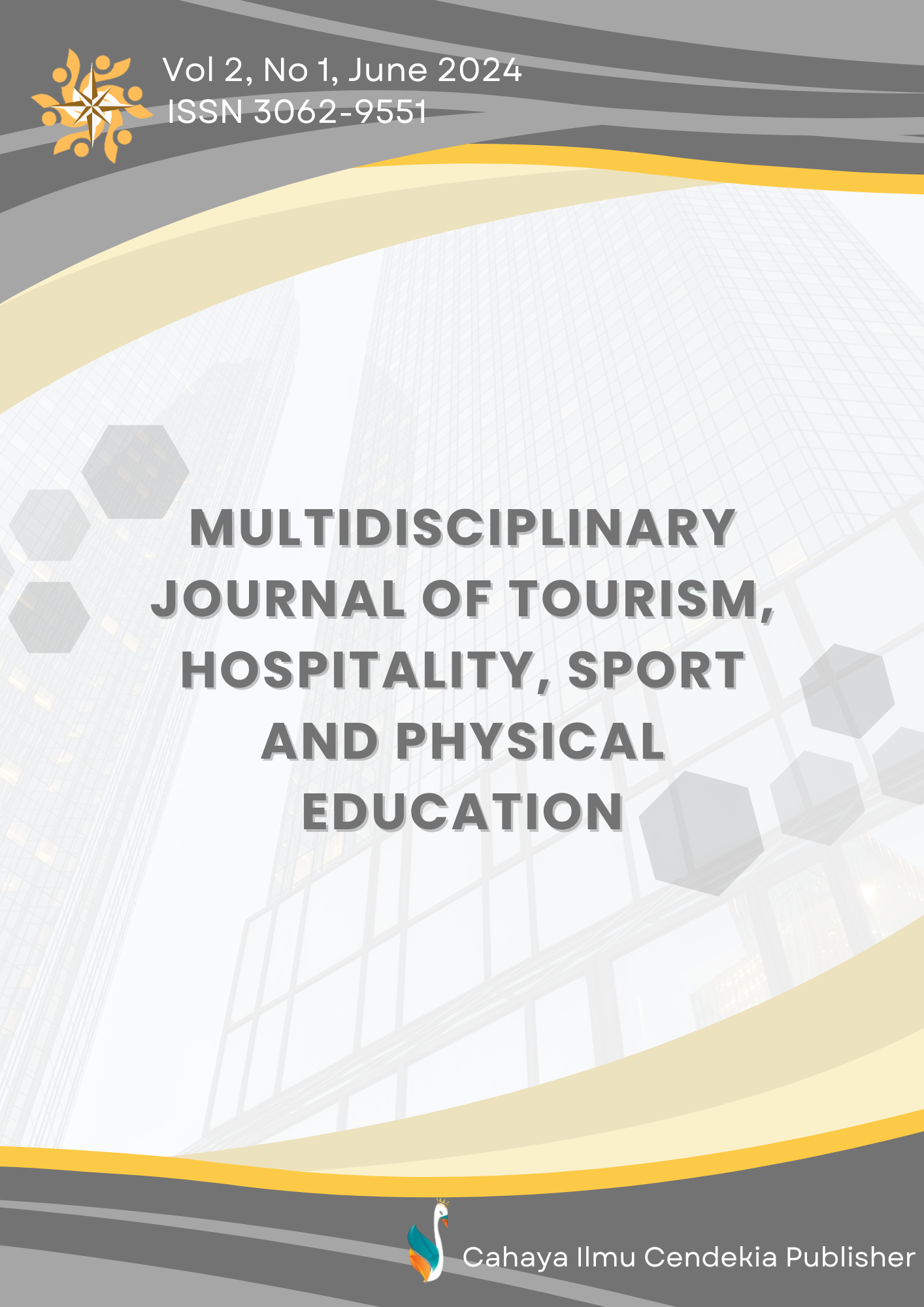Development Of Coastal Tourism Objects In Increasing Pad Banggai Laut Regency
Abstract
Purpose of the study: This study aims to describe the strategy for developing beach tourism objects and analyze their contribution to increasing Regional Original Income (PAD) in Banggai Laut Regency.
Methodology: This research used a descriptive qualitative method with purposive sampling. Data were obtained through observation, interviews, and documentation at the Department of Tourism, Banggai Laut Regency. Informants consisted of five individuals who were directly involved in tourism development and PAD management.
Main Findings: The development strategy includes coordination with tourism stakeholders, destination development, tourism marketing, and collaboration with tourism institutions. Contributions to PAD are derived from hotel tax, restaurant tax, entertainment tax, and special parking fees. Tourism activities significantly support local financial independence and economic growth in Banggai Laut Regency.
Novelty/Originality of this study: This study offers a contextual insight into how underutilized coastal tourism potential can be strategically developed to boost PAD. It highlights an integrated tourism development model involving local government collaboration and public-private synergy, which can serve as a reference for similar coastal regions in Indonesia.
References
E. Mulyantri, “Pengembangan objek wisata budaya : taman prasejarah leang-leang, Maros, Sulawesi Selatan,” Nucleic Acids Res., vol. 6, no. 1, pp. 1–7, 2018, doi: 10.36276/mws.v16i1.262.
Siti Hajar, “Tourism development policy throughe economic potential in supporting tourism and creative economy programs in the Lake Toba region,” Int. J. Heal. Econ. Soc. Sci., vol. 4, no. 1, pp. 18–30, 2022, doi: 10.56338/ijhess.v4i1.2160.
H. Mashithoh, A. Mulyana, and R. S. Wardhani, “The development strategy of halal nature tourism based on the empowerment of Bangka Belitung coastal community,” Integr. J. Bus. Econ., vol. 5, no. 2, p. 134, 2021, doi: 10.33019/ijbe.v5i2.363.
M. Carvalho, S. Martins, E. Santos, and A. B. S. de Carvalho, “The Fisherman’s Route - Project of sustainability and pedagogical practices,” J. Inf. Syst. Eng. Manag., vol. 7, no. 4, 2022, doi: 10.55267/IADT.07.12536.
E. W. Abbas, J. Jumriani, S. Syaharuddin, B. Subiyakto, and R. Rusmaniah, “Portrait of tourism based on river tourism in Banjarmasin,” Kalimantan Soc. Stud. J., vol. 3, no. 1, p. 18, 2021, doi: 10.20527/kss.v3i1.4145.
A. Polukhina, M. Sheresheva, M. Efremova, O. Suranova, O. Agalakova, and A. Antonov-Ovseenko, “The concept of sustainable rural tourism development in the face of COVID-19 crisis: Evidence from Russia,” J. Risk Financ. Manag., vol. 14, no. 1, 2021, doi: 10.3390/jrfm14010038.
P. Hema, “Analysis of the contribution of Bantimurung Bulusaraung Nature Tourism Park to the Original Regional Income ( PAD ) of Maros Regency,” Multidiscip. J. Tour. Hosp. Sport Phys. Educ., vol. 1, no. 2, pp. 60–69, 2024, doi: 10.37251/jthpe.v1i2.1187.
S. Mattiro, C. Widaty, and Y. Apriati, “Historical cultural maritime notes and the integration of its values in shaping the Self-Reliance of coastal ecotourism,” Yupa Hist. Stud. J., vol. 7, no. 2, pp. 194–210, 2023, doi: 10.30872/yupa.vi0.1937.
R. F. Oktaviana, A. S. Muhammad, F. Kurnianingsih, and M. Mahadiansar, “Internal condition analysis on tourism development of Bintan Regency 2019,” Indones. J. Tour. Leis., vol. 2, no. 1, pp. 51–61, 2021, doi: 10.36256/ijtl.v2i1.129.
F. Damanik, T. Rahayu, and H. Setyawati, “The analysis of the potential of sports tourism in Simalungun regency,” J. Phys. Educ. Sport., vol. 9, no. 3, pp. 198–203, 2020, [Online]. Available: https://journal.unnes.ac.id/sju/index.php/jpes/article/view/34391
B. AL HAZAR, S. SUMARMI, I. K. ASTINA, and R. P. SHRESTHA, “Mappalili ceremony in supporting unesco version of cultural tourism in maros- pangkep geopark,” Geoj. Tour. Geosites, vol. 52, no. 1, pp. 360–371, 2024, doi: 10.30892/gtg.52135-1212.
A. I. Syamsul Bahri, J. Usman, and F. Fatmawati, “Tourism resources development policy in increasing regional original revenue in Bulukumba regency,” J. La Soc., vol. 5, no. 4, pp. 1082–1090, 2024, doi: 10.37899/journal-la-sociale.v5i4.1231.
H. Zhang, “Analysis of the overall development mode of cultural tourism under the creative economy environment,” J. Environ. Public Health, vol. 2022, 2022, doi: 10.1155/2022/3498622.
E. Iskandar, Z. Taib, and M. R. Septriawan, “Developing a design model for seven charm (Sapta Pesona ) tourism awareness in the local community of Lake Toba,” Tradit. Mod. Humanit., vol. 2, no. 1, pp. 56–72, 2022, doi: 10.32734/tmh.v2i1.8538.
S. Brooks and S. Reynolds, “The exploration of becoming as a yoga practitioner and its impact on identity formation, health, and well-being,” J. Occup. Sci., vol. 31, no. 2, pp. 354–370, 2024, doi: 10.1080/14427591.2023.2253802.
J. P. Mihalik, R. C. Lynall, E. F. Teel, and K. A. Carneiro, “Concussion management in soccer,” J. Sport Heal. Sci., vol. 3, no. 4, pp. 307–313, 2014, doi: 10.1016/j.jshs.2014.07.005.
A. Timm et al., “Promoting men’s health through sports clubs: A systematic rapid realist review,” J. Sport Heal. Sci., vol. 14, p. 100969, 2024, doi: 10.1016/j.jshs.2024.100969.
L. M. Schwab Reese, R. Pittsinger, and J. Yang, “Effectiveness of psychological intervention following sport injury,” J. Sport Heal. Sci., vol. 1, no. 2, pp. 71–79, 2012, doi: 10.1016/j.jshs.2012.06.003.
H. Liu, W. E. Garrett, C. T. Moorman, and B. Yu, “Injury rate, mechanism, and risk factors of hamstring strain injuries in sports: A review of the literature,” J. Sport Heal. Sci., vol. 1, no. 2, pp. 92–101, 2012, doi: 10.1016/j.jshs.2012.07.003.
M. Lochbaum and J. Gottardy, “A meta-analytic review of the approach-avoidance achievement goals and performance relationships in the sport psychology literature,” J. Sport Heal. Sci., vol. 4, no. 2, pp. 164–173, 2015, doi: 10.1016/j.jshs.2013.12.004.
R. Li, “Why women see differently from the way men see? A review of sex differences in cognition and sports,” J. Sport Heal. Sci., vol. 3, no. 3, pp. 155–162, 2014, doi: 10.1016/j.jshs.2014.03.012.
M. Lochbaum, J. Jean-Noel, C. Pinar, and T. Gilson, “A meta-analytic review of Elliot’s (1999) hierarchical model of approach and avoidance motivation in the sport, physical activity, and physical education literature,” J. Sport Heal. Sci., vol. 6, no. 1, pp. 68–80, 2017, doi: 10.1016/j.jshs.2015.07.008.
G. Sjøgaard et al., “Exercise is more than medicine: The working age population’s well-being and productivity,” J. Sport Heal. Sci., vol. 5, no. 2, pp. 159–165, 2016, doi: 10.1016/j.jshs.2016.04.004.
Y. Guo, H. Shi, D. Yu, and P. Qiu, “Health benefits of traditional Chinese sports and physical activity for older adults: A systematic review of evidence,” J. Sport Heal. Sci., vol. 5, no. 3, pp. 270–280, 2016, doi: 10.1016/j.jshs.2016.07.002.
M. Caru, A. Levesque, F. Lalonde, and D. Curnier, “An overview of ischemic preconditioning in exercise performance: A systematic review,” J. Sport Heal. Sci., vol. 8, no. 4, pp. 355–369, 2019, doi: 10.1016/j.jshs.2019.01.008.
A. Vlahoyiannis, G. Aphamis, G. C. Bogdanis, G. K. Sakkas, E. Andreou, and C. D. Giannaki, “Deconstructing athletes’ sleep: A systematic review of the influence of age, sex, athletic expertise, sport type, and season on sleep characteristics,” J. Sport Heal. Sci., vol. 10, no. 4, pp. 387–402, 2021, doi: 10.1016/j.jshs.2020.03.006.
B. J. Stenner, J. D. Buckley, and A. D. Mosewich, “Reasons why older adults play sport: A systematic review,” J. Sport Heal. Sci., vol. 9, no. 6, pp. 530–541, 2020, doi: 10.1016/j.jshs.2019.11.003.
C. Towlson et al., “Maturity-associated considerations for training load, injury risk, and physical performance in youth soccer: One size does not fit all,” J. Sport Heal. Sci., vol. 10, no. 4, pp. 403–412, 2021, doi: 10.1016/j.jshs.2020.09.003.
J. Pérez-Gómez, J. C. Adsuar, P. E. Alcaraz, and J. Carlos-Vivas, “Physical exercises for preventing injuries among adult male football players: A systematic review,” J. Sport Heal. Sci., vol. 11, no. 1, pp. 115–122, 2022, doi: 10.1016/j.jshs.2020.11.003.
A. Zech et al., “Sex differences in injury rates in team-sport athletes: A systematic review and meta-regression analysis,” J. Sport Heal. Sci., vol. 11, no. 1, pp. 104–114, 2022, doi: 10.1016/j.jshs.2021.04.003.
R. Bertrand, H. Jonsson, I. Margot-Cattin, and B. Vrkljan, “A narrative analysis of the transition from driving to driving cessation in later life: Implications from an occupational lens,” J. Occup. Sci., vol. 28, no. 4, pp. 537–549, 2021, doi: 10.1080/14427591.2021.1879239.
T. Steimer, “Animal models of anxiety disorders in rats and mice: Some conceptual issues,” Dialogues Clin. Neurosci., vol. 13, no. 4, pp. 495–506, 2011, doi: 10.31887/dcns.2011.13.4/tsteimer.
C. W. Callaghan, “Contemporary HIV/AIDS research: Insights from knowledge management theory,” Sahara J, vol. 14, no. 1, pp. 53–63, 2017, doi: 10.1080/17290376.2017.1375426.
D. A. Adeniyi and M. F. Dinbabo, “Efficiency, food security and differentiation in small-scale irrigation agriculture: Evidence from North west Nigeria,” Cogent Soc. Sci., vol. 6, no. 1, 2020, doi: 10.1080/23311886.2020.1749508.
H. von Kürthy, K. Aranda, G. Sadlo, and G. Stew, “Embroidering as a transformative occupation,” J. Occup. Sci., vol. 30, no. 4, pp. 647–660, 2023, doi: 10.1080/14427591.2022.2104349.
S. Lovestone, “Fleshing out the amyloid cascade hypothesis: the molecular biology of Alzheimer’s disease,” Dialogues Clin. Neurosci., vol. 2, no. 2, pp. 101–110, 2000, doi: 10.31887/dcns.2000.2.2/slovestone.
I. Wenger, S. Kantartzis, H. Lynch, C. Schulze, and J. Jackson, “Making secret hiding places: An occupation of childhood,” J. Occup. Sci., vol. 31, no. 1, pp. 118–131, 2024, doi: 10.1080/14427591.2023.2240815.
R. C. Gur and R. E. Gur, “Memory in health and in schizophrenia,” Dialogues Clin. Neurosci., vol. 15, no. 4, pp. 399–410, 2013, doi: 10.31887/dcns.2013.15.4/rgur.
E. J. Crawford, E. C. Crook, L. Waldby, and P. Douglas, “New perspectives on responsive infant care: A qualitative study of the ways in which Neuroprotective Developmental Care (NDC) shapes mother-infant co-occupations,” J. Occup. Sci., vol. 31, no. 2, pp. 337–353, 2024, doi: 10.1080/14427591.2023.2236117.
C. Håkansson, A. B. Gunnarsson, and P. Wagman, “Occupational balance and satisfaction with daily occupations in persons with depression or anxiety disorders,” J. Occup. Sci., vol. 30, no. 2, pp. 196–202, 2023, doi: 10.1080/14427591.2021.1939111.
Y. Liu, R. Zemke, L. Liang, and J. M. L. Gray, “Occupational harmony: Embracing the complexity of occupational balance,” J. Occup. Sci., vol. 30, no. 2, pp. 145–159, 2023, doi: 10.1080/14427591.2021.1881592.
W. Kurevakwesu, E. Mthethwa, K. Chirangwanda, and T. Mabeza, “Parental perceptions towards reintegration of pregnant girls and teenage mothers into the education system in Zimbabwe,” Cogent Soc. Sci., vol. 9, no. 1, 2023, doi: 10.1080/23311886.2023.2186564.
A. Tebandeke and R. Premkumar, “Political and socio-economic instability: does it have a role in the HIV/AIDS epidemic in sub-saharan africa? case studies from selected countries,” Sahara J, vol. 8, no. 2, pp. 65–73, 2011, doi: 10.1080/17290376.2011.9724987.
A. Aguzzi, “Recent developments in the pathogenesis, diagnosis, and therapy of prion diseases,” Dialogues Clin. Neurosci., vol. 3, no. 1, pp. 25–36, 2001, doi: 10.31887/dcns.2001.3.1/aaguzzi.
H. Georgiou, K. Maton, and M. Sharma, “Recovering knowledge for science education research: Exploring the ‘Icarus Effect’ in student work,” Can. J. Sci. Math. Technol. Educ., vol. 14, no. 3, pp. 252–268, 2014, doi: 10.1080/14926156.2014.935526.
Copyright (c) 2025 Siti Fazryanti Rahmad

This work is licensed under a Creative Commons Attribution 4.0 International License.
Authors who publish with this journal agree to the following terms:
- Authors retain copyright and acknowledge that the Journal of Health Innovation and Environmental Education is the first publisher licensed under a Creative Commons Attribution 4.0 International License.
- Authors are able to enter into separate, additional contractual arrangements for the non-exclusive distribution of the journal's published version of the work (e.g., post it to an institutional repository or publish it in a book), with an acknowledgment of its initial publication in this journal.
- Authors are permitted and encouraged to post their work online (e.g., in institutional repositories or on their website) prior to and during the submission process, as it can lead to productive exchanges and earlier and greater citation of published work.


.png)
.png)
.png)



